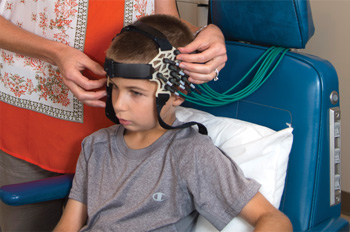
Neuroimaging technology offers unprecedented means to study brain activity during natural speech production. Photo by Mark Simons
Although one out of every 20 preschoolers experiences a period of stuttering, the majority of children who stutter — some 75 percent — "grow out of it" with or without treatment. But what about the 25 percent who persist and grow into adults who stutter?
That question drives the work of Bridget Walsh (PhD '07), a research scientist in the Department of Speech, Language, and Hearing Sciences. Funded by a three-year grant from the National Institutes of Health, Walsh is embarking on a new study of the neural mechanisms that contribute to stuttering in children.
"Converging evidence from nearly two decades of neuroimaging research in adults who stutter reveals subtle and diffuse differences in both the structure and function of the brain networks involved in speech production," Walsh says. "However, we know far less about neural activity for speech in children who stutter, whose brains are markedly different from adults' as they are undergoing developmental growth and refinement. We don't know if the differences we see in adults who stutter are the cause of stuttering or the result of years of persistence and compensation."
Walsh says most neuroimaging technologies are also highly sensitive to movement, making it inherently difficult to image speech production. As a result, many of the earlier studies in adults who stutter relied upon brief, unnatural speaking tasks to circumvent this problem.
"The neuroimaging technology I use for my research, Functional Near-Infrared Spectroscopy (fNIRS), offers an unprecedented means to study brain activity during natural speech production," Walsh says.
fNIRS is a noninvasive optical imaging method that measures the relative changes in oxygenated and deoxygenated hemoglobin in the outer layers of the brain called the cortex. Similar to PET and fMRI, it provides an indirect index of brain activity; however, it is far less sensitive to motion artifact. It is safe, requires fewer trials and offers the significant advantage of recording brain activity while a person is speaking, Walsh says.
To gather more accurate data, Walsh customized leading-edge fNIRS technology by designing a 3-D printed headpiece for children that holds the sources and detectors. The sources emit a harmless amount of infrared light that penetrates the cortex. The detectors measure changes in the diffused light. "By positioning the headpiece over specific brain regions involved in speech production, we can learn if there are differences in the lateralization and timing of brain activity in children who stutter while they are describing what they see in the different pictures that I present to them," she says.
Walsh is analyzing data from trials conducted this summer in Lyles-Porter Hall with more than 35 children who do and do not stutter. Findings from this project are a critical step for future work using these noninvasive methods to identify possible neural characteristics of young children at risk for persistence in stuttering.
"We want to know if there are neurological signatures or markers that, along with other risk factors, may help us predict which children are more likely to persist in stuttering into adulthood," Walsh says.











